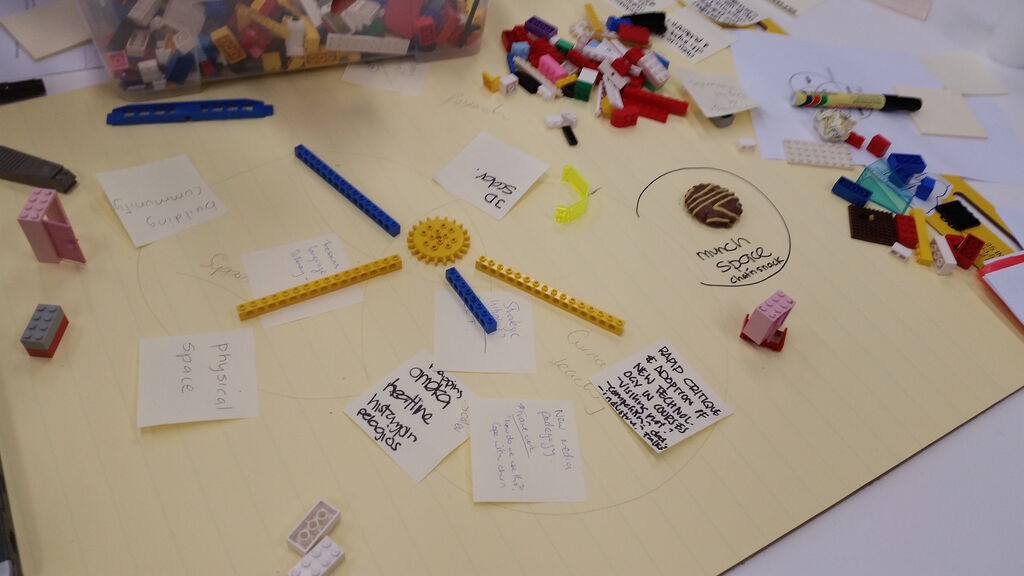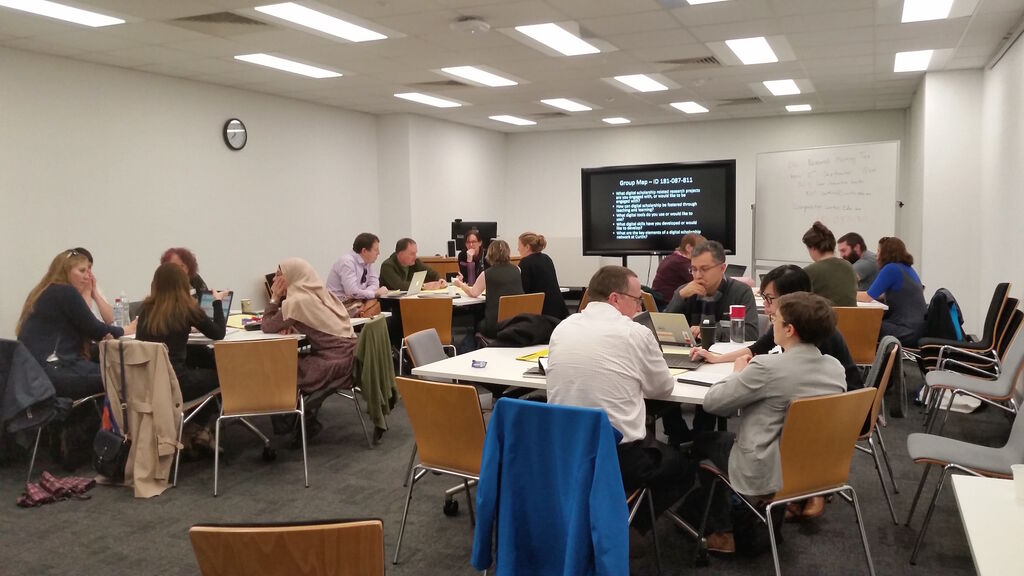Blog
Digital Scholarship and the Humanities
October 17th, 2016 by Karen Category: News and Events


The Curtin Library Makerspace recently celebrated Research Week at Curtin University by hosting a workshop entitled ‘Supporting Digital Scholarship in the Humanities’. Using a definition of digital scholarship as “the use of digital evidence and method, digital authoring, digital publishing, digital curation and preservation, and digital use and reuse of scholarship.” (Abby Smith Rumsey), the aim of the workshop was to explore the techniques and challenges of digital scholarship in the humanities, identify the skills required, and develop ideas around how we could best support and foster this important area of emerging scholarship at Curtin.
What follows is a summary of the ideas that came out the workshop as we explored the question: if we were to grow a digital scholarship network or community of practice at Curtin, what would it look like?
Context for the workshop
Underpinning the workshop was the acknowledgement that new and emerging technologies are impacting scholarship across all disciplines, affecting the way in which research and teaching is conducted, disseminated, created, and preserved. Within the humanities, the use of new digital tools and methods has given rise to collaboration, experimentation and innovation in areas such as visualisation, digitisation, 3-D mapping, and electronic textual analysis, and in so doing, raising new questions and perspectives.
In order to develop and publish successful digital humanities projects using available tools and source materials, researchers and students need new skill sets. The academic library has a significant role to play in this process, as is evident in the growth of partnerships and collaborations between the library and humanities faculty, such as the development of digital scholarship centres. Indeed, according to the ACRL, digital scholarship is one of the top library trends of 2016.
Curtin Library has expertise and knowledge in a number of areas that can support digital scholarship. Some, such as data management or the Library makerspace, are only just emerging while others, such as archiving, scholarly publishing, and institutional repositories, are more established. Within the Curtin humanities faculty there is also a wealth of experience, and many current projects which fit within the realm of digital scholarship. However, many of these existing elements are disparate and tenuously connected, with seemingly few avenues for researchers to either learn or develop the skills necessary to conduct digital humanities research, or to share their experience and knowledge.
The workshop
The first hour of the workshop was framed around four different viewpoints presented by the facilitators Lise Summers, Matthias Liffers, myself (Karen Miller) and Erik Champion. After morning tea the 25 participants then worked in small groups to discuss a range of questions and finished off by constructing lego models conceptualising the ideal digital scholarships support network.
Several themes emerged from the talks and the discussion. They were
- Digitisation and digital preservation
- Digital literacy /digital fluency – what tools & skills need to be learned?
- Digital scholarship/humanities network /infrastucture
Digital preservation
Dr Lise Summers spoke from her perspective as an archivist, historian and researcher, as well as her work teaching information studies students about archives and preservation of digital materials. She pointed out the lack of clarity around what facilities are available at Curtin to help with digital humanities work and posed a series of questions: Is there somewhere that collects and collates this information? Who trains researchers and advises them on file naming, format choices and so on? What tools and software is available – do I “roll my own”, or is it pre-installed somewhere, and can I use it? What equipment is available? Is there equipment available, or digitisation facilities? If so, how can we access it? What about oral history research?
In relation to digital preservation Lise asked: How well do people understand the long and short term preservation requirements of their data? Most of the discussion is about the research and then publication, but what happens to the data? As an historian, if I write my notes in pencil, should I scan them to the R:drive? How do I get access if I leave the University? What about if I take lots of images of material to then re-use for my research – what happens to that? What do I need to do to make it accessible? What limitations are there? Do we have a research data curator? Do we have a research data archivist or digital preservation support? Should we?
Digital fluency
Some of Lise’s questions were answered by Matthias Liffers, research coordinator at Curtin Library, who talked about the Library’s role in providing support for research data management for Curtin researchers, including teaching a range of skills to help researchers understand and manage data. For example, in collaboration with the Curtin Institute for Computation (CIC), the Library helps to run software carpentry workshops (there is one coming up in November) and Hacky Hour (every Wednesday 3 pm at Common ground), which are designed to teach and support programming skills and projects. Rebecca Lange, the Humanities computational person of CIC also spoke about other services, events and programs being run through the CIC.
Another area of Library support that I highlighted was the Curtin Makerspace, which over the past 18 months has been running events and workshops designed to develop a maker community, connecting people together to collaborate on cross-disciplinary ‘making’ projects. Some of the project examples I pointed to were:
- integrating lego and Minecraft making activities into the information studies curriculum
- researchers and students collaborating to create a GUI for the Kinect v 2 to enable physical interaction with digital environments
- hosting “creating VR sessions conducted by AVR network
- contributing to #GLAMVR16 and the upcoming Curtin Cultural Makathon
By participating in projects and events like these, the Makerspace aims to help students and researchers develop digital fluency through a constructivist approach to learning through making, which involves using and interacting with digital tools and engaging with technology to design and create.
The discussion around what tools and skills are required was interesting. Generally people felt that it was important to not only learn the skills to use tools, but to learn to interact and engage with the technology in a creative way. Specific skills identified as important were digital archiving and preservation, WMPU wrangling, visualisation, learning different coding languages, while areas of interest discussed were altmetrics, game prototyping, AR and VR workflows, 360 and 3D. Specific tools that people mentioned wanting to learn to use were Omeka, Scalar, Unity and Minecraft.
The DiRT Directory was highlighted as a valuable support for the development of relevant skills. The DiRT Directory aggregates information about digital research tools for scholarly use, which makes it easy for digital humanists and others conducting digital research to find and compare resources ranging from content management systems to music OCR, statistical analysis packages to mindmapping software.
Some of the points that were raised in relation to skill development were:
- A key element is building community, a participatory culture, a common language and a framework.
- The Library can support technologies that researchers can use e.g. reference managers, collaborative writing tools, visualisation tools, and data formatting for open publishing
- It’s important to bring technology into humanities teaching, by using Digital Humanities approaches in the classroom. Encourage student-led projects and events such as hackathons. Create a course. Digital literacy for teachers is also important.
- Researchers can show how these skills/technologies need to be modified, how they affect research, how they are themselves areas of research. This involves making things with a critical attitude, asking whether it achieves its purpose, analysing the process.
- We can develop the research component of makerspace projects using the ideas around ‘critical making’, and encourage development of projects leading to creative and scholarly output. We can invite visiting scholars or technical people to teach. We can explore the possibility of an ejournal consortium using platforms designed for the scholarly publication of digital humanities research.
Digital scholarship infrastructure
To encourage discussion around digital scholarship infrastructure Erik talked about his prior experience as the project leader of Dighumlab [http://dighumlab.com/] a collaborative network of 4 universities (and now 2 libraries) in Denmark. In this role, some of the questions he asked himself were:
• What is a research infrastructure?
• What do we mean by a laboratory – is there only one?
• What kind of databases do we have?
• What about funding?
• Who is the audience?
• What should we deliver and when?
• What are the goals for success after the contract period and how do we measure it?
Erik suggested that genuine infrastructures invest and support not just equipment but also people, skills, training, exchanges, and enthusiasm. Most digital humanities centres are resource based or centre-based, while few are distributed. But the most important thing is to work out who you want to work for and with and what resources and profile you hope to focus around.
Are we talking about a cluster, centre or lab, and is it for learning, scholarship or support? While all three are integral, he suggested that perhaps focussing on one or two was important, and to ensure knowledge is carried on past individuals and some of the research aims to evaluate, maintain and improve the quality or quantity of that information (it should not just be a pipeline, the pipeline itself should also be an area of research).
Erik also stressed that some form of meeting space, such as the Curtin Makerspace, is important, as are archives (the Library has that but perhaps it needs to start looking at new more public focussed ones as well), and there are related degrees. Hosting workshops and inviting experts to come and talk in areas we want to learn more about or connect with, is also important and can be very fruitful. For example, with DigHumLab Erik organised a one day conference with 6 invited and 4 local speakers which led to finding partners for an EU project application, further meetings, invitations to conferences and talks and a conference in Copenhagen on cultural heritage tools and archives which will result in a book publication.
To generate ideas from the group around what a digital scholarship network might look like at Curtin, we worked in groups to build lego models that represented the ideal digital scholarship infrastructure. The discussion around the models identified some key ideas of digital scholarship as:
- a place – where we can come together to talk, centralised but connects to other physical and virtual areas
- a toolbox – collection of stuff where we can pull out what we need and have guidance in how to connect the elements together
- a process – which is open and transparent, where we can see what is happening underneath
- a network – of people, relationships, collaboration, working together to build a community of practice
The workshop was a valuable opportunity to share ideas. We went away with a feeling that we have started an important conversation that will continue as we take the next steps in the process of supporting digital scholarship in the humanities at Curtin.
